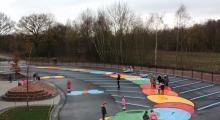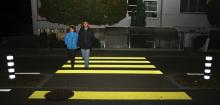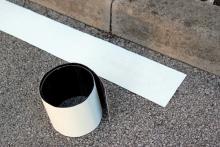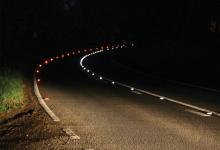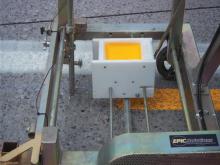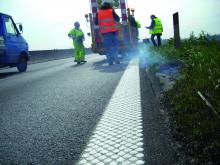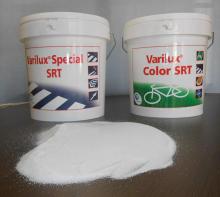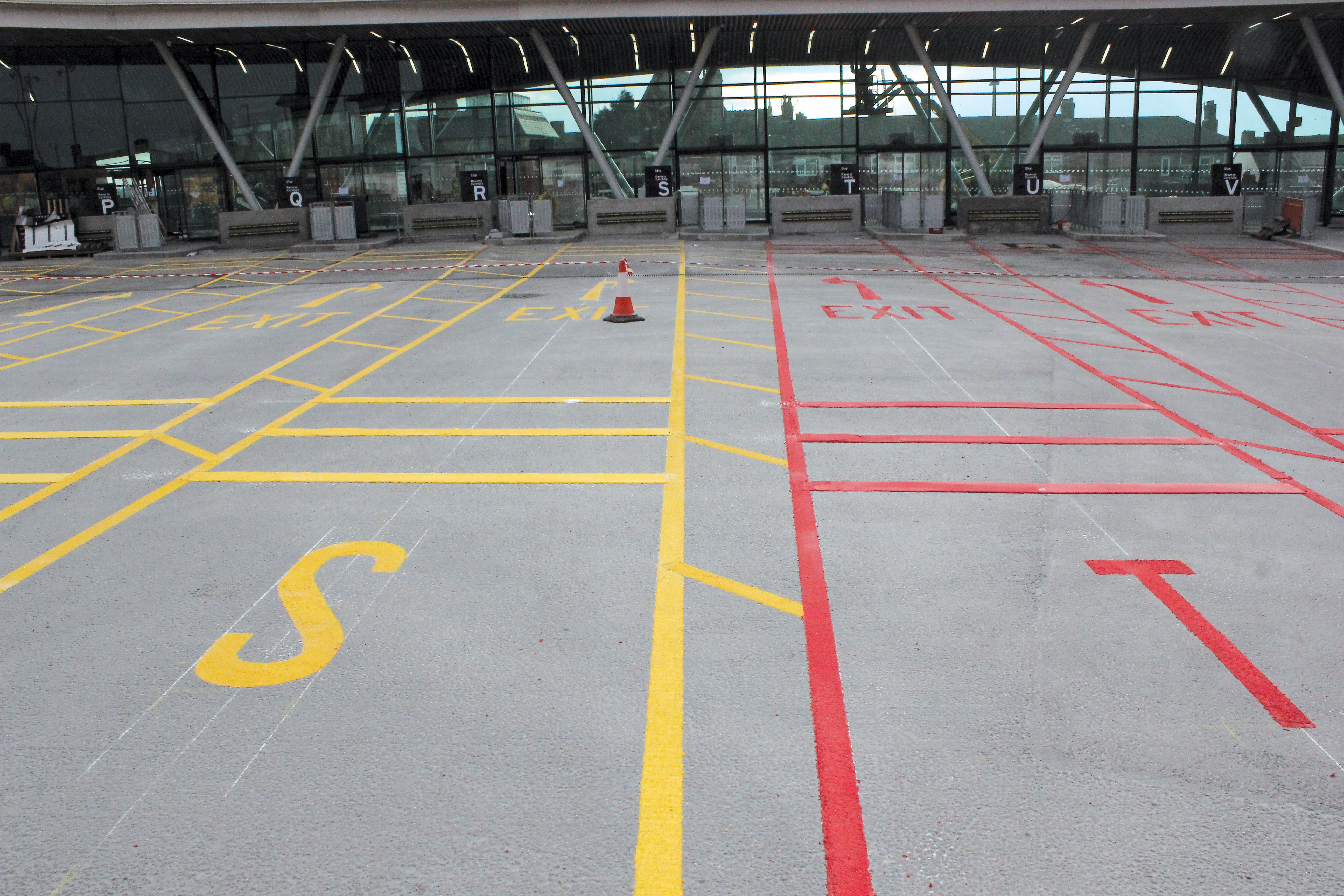
A UK student hopes his new lenticular road signs which ‘pulse’ at drivers will lead to a revolution in the way motorists are given information on the roads. Meanwhile, a leading road marking firm is helping keep tourists safe in a spiritually significant town in Umbria, Italy. Guy Woodford reports
You may think Charles Gale’s vision of creating the first ‘pulsing’ lenticular road sign was the result of months, even years, spent studying traffic and driver behaviour on the roads of his adopted student city of Nottingham in central England.But it turns out it was nothing to do with a hard-earned roadside revelation – and everything to do with what can be inadvertently achieved through a visit to your nearest bookshop.
“I was in the Nottingham Trent University bookshop at the beginning of this year and at the counter they sell lenticular bookmarks. They had one that had different figurines doing sporting motions: one running and another riding a bike,” explained Gale. “I then thought of the famous ‘Children crossing the road sign’, with the two children holding hands, and thought ‘Why can’t you animate that sign with the same technology? - making the danger more apparent to road users.”
Keen to make swift progress with his idea, the student of product design at NTU’s School of Architecture, Design and the Built Environment obtained several lenticular samples to “really understand” the technology a lot more. At the same time, he purchased a lot of road signs and studied his collection of articles under a digital microscope, looking at how the lenses and reflective vinyl interacted and what you can do with them. He then began gradually working up his designs to full scale road sign prototypes.
Incredibly, Gale said it took him “probably no more than a month” to go from his Eureka bookshop moment to the completion of his first lenticular road sign.
“It was a full-time project for me. I was working on it 9 until 5 every day, as well as numerous all-nighters,” he explained. “Almost from the start of the idea, it was very clear what I had to do. It was just how I did it.”
What was difficult, said Gale, was not being able to talk to anyone about his idea.
“Trying to get advice from anyone outside the University, anyone in IP (Industry Property Research) or experts in lenticulars and road safety was not possible. I couldn’t say a word. As soon as it [the idea] is in the public domain, you can’t patent it.”
Explaining the innovation of his road sign design, Gale said, “Lenticular lenses can be used to do a variety of different things. They are most commonly used on bookmarks and on magazine covers. You can give the impression of a 3D object depth, or animation. I’m using them in a way that I’ve never seen used before which is to change the retroreflectivity of an overall sign, using the lenses in conjunction with retroreflective vinyl to dynamically change perceived optical properties.”
Gale’s patent pending design has been inspired by calls for an overhaul of the UK's road signage network, which has been criticised as being cluttered and confusing by a number of people, such as UK parliamentary under-secretary of state for transport Norman Baker MP.
“Since their implementation in 1963 with Margaret Calvert, the signs haven’t changed that much, but the world which drivers operate in has. You’ve got sat navs, roadside advertising, brightly lit shop windows - everything fighting for your attention. [Current] road signs are static, could be called boring, and people don’t perceive the information as really that important anymore. When, in fact, the only law on the road is the road signs, not your sat nav.”
Current solutions to improve road safety, said Gale, focus on LED-based technology which, he believes, has limitations compared to his plastic and ink-based road signs.
“Replacing static signs with high-tech, electric products which track vehicle movements and respond with LED animations is an overcomplicated response to the problem. These [LED-based solutions] are very expensive, require maintenance, and in rural areas you require complex electrical supply systems. You have to completely uproot existing signs. With these [lenticular signage] you can stick the lens on the front of the existing sign for very little money.”
Gale has founded his own company, Keyframe Signage, with the help of NTU’s centre for entrepreneurship and enterprise, The Hive.
Once his patent has been fully approved, the 22-year-old from Reigate, Surrey, is looking to license the design to existing manufacturers rather than make the products himself.
“I’ve been contacted by a variety of businesses. The difficulty that I’ve faced at the moment is that these signs are not approved by any department of transport. It’s a new technology that will need to be tested and approved. Road signage and road safety is critical, so all the negotiations have been on the assumption that when tested these would be approved. There’s no real reason, so I’ve been told, that they wouldn’t be, and I’m already in negotiations with the required people to make this happen.”
Gale is also exploring the potential to apply the technology to other signs, such as those for fire escapes.
“With other signage, like fire escapes and private signage, like race track signage, there are so many markets that can be tapped.
“I can licence this [technology] as patent pending and I’m looking at getting this into as many industries as possible, but not in a financial way. I think it’s a technology that, as many people have said, seems crazy for not having been used before. As a designer I have an obligation to make my work have as big and impact as possible, especially as it has the potential to save lives.”
At least 100,000 visitors, including numerous pilgrims, come to the town of Gubbio, in north-east Umbria, Italy, each year in order to trace the footsteps of St. Francis of Assisi. Ensuring their safety and that of the 33,000 residents of Gubbio is a key issue for the municipal administration.
To ensure safety, reliable crosswalk markings are essential. The local police authorities, who are responsible for maintaining the roads and markings, had previously worked with companies that offered traditional paints with a limited service life. Preformed thermoplastic materials did not produce the required results and the authority’s representatives were said to be equally skeptical about MMA cold spray plastic. In order to convince them of the benefits of MMA cold spray plastic, a two-component
For the evaluation, a crosswalk was selected in a particularly critical zone with the highest traffic density and where paint and thermoplastic materials had demonstrated their weak points.
After a five-month test phase characterised by heavy snowfall, salt spreading and the use of snowploughs, those responsible were persuaded that the markings had not eroded. In the months that followed, DEGAROUTE-based spray road markings were applied to around 80 crosswalks and other areas in the town centre and adjacent suburbs. Materials were applied with a thickness of 30mils (800micrometres and glass beads were later applied in order to improve night visibility (9.5 lb/ft² / 0.4 kg/m²).
For the municipal administration of Gubbio, Evonik claims there are many advantages of using MMA cold spray plastic. DEGAROUTE is said to take just 10 to 15 minutes to apply, while providing durability for three to four years. This considerably minimises disruptions to traffic on Gubbio’s mainly single-lane roads. Another plus is the road marking’s retroreflectivity and slip resistance, particularly in wet conditions, that takes effect as soon as the MMA cold spray plastic road markings are applied. All these factors are said to have been certified by
Evonik says that for municipalities experiencing budget constraints, one of the most important decision factors is the cost-efficiency of the materials being applied. From this perspective, the firm says DEGAROUTE-based MMA cold spray plastic is unbeatable, especially when its service life of up to four years is taken into consideration.
If the town of Gubbio had continued to use traditional road marking paints, Evonik says its authorities would have had to replace the markings twice a year. By using the two-component cold plastic based on DEGAROUTE, Evonik claims local authorities can realise savings of 50% compared to traditional road markings. When compared with the preformed thermoplastic markings, the savings are said to be even greater at around 70%.
Environmental protection considerations were not ignored either, according to Evonik. The VOC (Volatile Organic Compound) percentage of the two-component MMA cold spray plastic is 0%. There are many advantages to cold spray plastic and, in the long run, it is said by Evonik to be the best value road marking material. Moreover, the amount of transport and the number of applications required are said to be reduced due to the durability of the DEGAROUTE-based MMA cold spray plastic.
“With the new marking system, we’ve made the town of Gubbio safer for residents and visitors and we’ve also made a contribution to environmental protection,” said Elisa Floridi, the local police commander.
Ennis Prismo has provided milled road studs and low speed rumble strips to warn bus drivers when they are approaching the end of a bus stand at a new multi-million dollar bus station in Stoke-on-Trent, central England.
With safety a prime concern for bus operators, bus drivers, the station manager and the travelling public, and the architects also keen on finding an attractive road safety marking solution, Ennis Prismo concentrated on a solution that would not only be physically detected by the bus drivers but also visible at night.
Stimsonite model C80 studs were chosen for the key safety assignment due to their hardened cast iron housings designed to withstand heavy trafficking. This particular model of stud also provides engineered ramps that protect the reflective lens from vehicles.
With 120 buses travelling in and out of the station every hour, the line marking plays a key part in optimising safety for pedestrians and bus drivers – one of the key attributes for public transport infrastructure. High reflective MMA paint with glass beads embedded is said by Ennis Prismo to improve the reflectivity to such a degree that bus drivers can clearly see the markings at all times.
Both yellow and red paint was used to complete the lining, clearly marking out different designated areas.
The new bus station has cost around US$22.79 million (£15m) so that bus passengers can now enjoy the latest state-of- the-art facilities. The site now plays host to 22 bus departure bays, interactive touchscreen bus journey planners, convenience store, waiting lounge and toilets for bus travellers. With the bus station in full operation from 5am until midnight, the facility has a 24-hour staff presence and CCTV to discourage any anti-social behaviour.
RSMA’s sign cut call
Britain’s most historic cities and biggest events could cut sign clutter at a stroke by adopting simple join-the-dots, colour-coded route marks for visitors, says the
New marking technology means permanent or temporary markings can be laid for just a few hundred pounds; replacing unsightly forests of signs and providing clear information on roads and pavement instead.
While permanent markings provide attractive alternative signage for tourist attractions, temporary markings, using a resin that can be softened with a mild detergent and then removed with a low-pressure water spray, are ideal for one-off events such as summer festivals and shows. The temporary markings meet the requirements of the
“It is time we addressed the proliferation of road signs and signposts throughout the UK, particularly in our historic towns and cities and picturesque villages.
Just look at an average-sized city like Sheffield, for example, which has an astounding 28,000 street signs and 18,000 items of street furniture,” said George Lee, national director of the RSMA.
“The UK remains firmly in the world’s top 10 tourist destinations, while the slow economy continues to make ‘staycations’ and ‘daycations’ attractive for Britons. All too often, planners and event organisers opt for the conventional sign on a pole to direct visitors, leading to cluttered, confusing signage and obstacles at every turn,” added Lee.
The RSMA national director said road, pavement or bike lane markings can be made temporary, such as for this year’s London Marathon, which were laid the night before the run, and removal completed within eight hours of the finish.
The Campaign to Protect Rural England (CPRE) is pressing for a reduction in the number of roads signs and signposts. The CPRE’s senior transport campaigner, Ralph Smyth, said, “Strong policies against cluttered streetscapes and landscapes need to be backed up by clutter audits to assess the problem. With public spending limited and the public calling for action, it makes sense to encourage community groups to assess and address the problem in the local areas they know best.”

